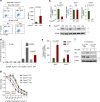Identification of FOXM1 as a therapeutic target in B-cell lineage acute lymphoblastic leukaemia
- PMID: 25753524
- PMCID: PMC4366523
- DOI: 10.1038/ncomms7471
Identification of FOXM1 as a therapeutic target in B-cell lineage acute lymphoblastic leukaemia
Abstract
Despite recent advances in the cure rate of acute lymphoblastic leukaemia (ALL), the prognosis for patients with relapsed ALL remains poor. Here we identify FOXM1 as a candidate responsible for an aggressive clinical course. We show that FOXM1 levels peak at the pre-B-cell receptor checkpoint but are dispensable for normal B-cell development. Compared with normal B-cell populations, FOXM1 levels are 2- to 60-fold higher in ALL cells and are predictive of poor outcome in ALL patients. FOXM1 is negatively regulated by FOXO3A, supports cell survival, drug resistance, colony formation and proliferation in vitro, and promotes leukemogenesis in vivo. Two complementary approaches of pharmacological FOXM1 inhibition-(i) FOXM1 transcriptional inactivation using the thiazole antibiotic thiostrepton and (ii) an FOXM1 inhibiting ARF-derived peptide-recapitulate the findings of genetic FOXM1 deletion. Taken together, our data identify FOXM1 as a novel therapeutic target, and demonstrate feasibility of FOXM1 inhibition in ALL.
Figures







Similar articles
-
Down-regulation of FoxM1 by thiostrepton or small interfering RNA inhibits proliferation, transformation ability and angiogenesis, and induces apoptosis of nasopharyngeal carcinoma cells.Int J Clin Exp Pathol. 2014 Aug 15;7(9):5450-60. eCollection 2014. Int J Clin Exp Pathol. 2014. PMID: 25337187 Free PMC article.
-
Inhibition of Forkhead box protein M1 by thiostrepton increases chemosensitivity to doxorubicin in T-cell acute lymphoblastic leukemia.Mol Med Rep. 2015 Jul;12(1):1457-64. doi: 10.3892/mmr.2015.3469. Epub 2015 Mar 11. Mol Med Rep. 2015. PMID: 25760224
-
Expression of Forkhead box M1 in soft tissue leiomyosarcoma: Clinicopathologic and in vitro study using a newly established cell line.Cancer Sci. 2016 Jan;107(1):95-102. doi: 10.1111/cas.12846. Epub 2016 Jan 12. Cancer Sci. 2016. PMID: 26560505 Free PMC article.
-
Role and regulation of the forkhead transcription factors FOXO3a and FOXM1 in carcinogenesis and drug resistance.Chin J Cancer. 2013 Jul;32(7):365-70. doi: 10.5732/cjc.012.10277. Epub 2013 May 27. Chin J Cancer. 2013. PMID: 23706767 Free PMC article. Review.
-
Insights into a Critical Role of the FOXO3a-FOXM1 Axis in DNA Damage Response and Genotoxic Drug Resistance.Curr Drug Targets. 2016;17(2):164-77. doi: 10.2174/1389450115666141122211549. Curr Drug Targets. 2016. PMID: 25418858 Free PMC article. Review.
Cited by
-
Senescent lung-resident mesenchymal stem cells drive pulmonary fibrogenesis through FGF-4/FOXM1 axis.Stem Cell Res Ther. 2024 Sep 18;15(1):309. doi: 10.1186/s13287-024-03866-2. Stem Cell Res Ther. 2024. PMID: 39289765 Free PMC article.
-
Olaparib-induced Adaptive Response Is Disrupted by FOXM1 Targeting that Enhances Sensitivity to PARP Inhibition.Mol Cancer Res. 2018 Jun;16(6):961-973. doi: 10.1158/1541-7786.MCR-17-0607. Epub 2018 Mar 15. Mol Cancer Res. 2018. PMID: 29545475 Free PMC article.
-
Tetramethylpyrazine inhibits prostate cancer progression by downregulation of forkhead box M1.Oncol Rep. 2017 Aug;38(2):837-842. doi: 10.3892/or.2017.5768. Epub 2017 Jun 29. Oncol Rep. 2017. Retraction in: Oncol Rep. 2024 Nov;52(5):152. doi: 10.3892/or.2024.8811. PMID: 28677763 Free PMC article. Retracted.
-
ABL1-mediated phosphorylation promotes FOXM1-related tumorigenicity by Increasing FOXM1 stability.Cell Death Differ. 2024 Oct;31(10):1285-1301. doi: 10.1038/s41418-024-01339-w. Epub 2024 Jul 26. Cell Death Differ. 2024. PMID: 39060421 Free PMC article.
-
Distinctive molecular features of regenerative stem cells in the damaged male germline.Nat Commun. 2022 May 6;13(1):2500. doi: 10.1038/s41467-022-30130-z. Nat Commun. 2022. PMID: 35523793 Free PMC article.
References
Publication types
MeSH terms
Substances
Grants and funding
- 101880/WT_/Wellcome Trust/United Kingdom
- U10 CA021115/CA/NCI NIH HHS/United States
- U24 CA196172/CA/NCI NIH HHS/United States
- CA175380/CA/NCI NIH HHS/United States
- R01 CA175380/CA/NCI NIH HHS/United States
- R01 CA157644/CA/NCI NIH HHS/United States
- R01 CA172558/CA/NCI NIH HHS/United States
- CA177655/CA/NCI NIH HHS/United States
- R01 CA177655/CA/NCI NIH HHS/United States
- R01CA169458/CA/NCI NIH HHS/United States
- 18131/CRUK_/Cancer Research UK/United Kingdom
- R01CA139032/CA/NCI NIH HHS/United States
- R01CA137060/CA/NCI NIH HHS/United States
- R01 CA169458/CA/NCI NIH HHS/United States
- U10 CA180820/CA/NCI NIH HHS/United States
- R01 CA139032/CA/NCI NIH HHS/United States
- R01CA157644/CA/NCI NIH HHS/United States
- U24 CA114737/CA/NCI NIH HHS/United States
- R01CA172558/CA/NCI NIH HHS/United States
- U10 CA180827/CA/NCI NIH HHS/United States
- R01 CA137060/CA/NCI NIH HHS/United States
LinkOut - more resources
Full Text Sources
Other Literature Sources
Molecular Biology Databases
Research Materials
Miscellaneous

